Progress in Methanol Steam Reforming Modelling via Membrane Reactors Technology
Abstract
:1. Introduction
2. Inorganic Membrane Reactor Technology
2.1. Palladium Membranes
- hydrogen molecules adsorption from the membrane;
- dissociation of hydrogen molecules on the membrane surface;
- reversible dissociative chemisorption of atomic hydrogen;
- reversible dissolution of atomic hydrogen in the metal lattice of the membrane;
- diffusion into the metal of atomic hydrogen proceeds from the higher hydrogen pressure to the lower hydrogen membrane side;
- desorption of re-combined atomic hydrogen into molecular form.
2.2. MRs Modelling
2.2.1. White Box or Theoretical Models
2.2.2. Black Box or Empirical Models
2.2.3. Grey Box or Semi-Empirical Models
2.2.4. Further Reactor Modelling Categorization
2.2.5. Tubular MR Modelling
- 1-D model, plug-flow;
- 1-D model with axial diffusion;
- 2-D model with axial and radial diffusion;
- 3-D model with axial, radial and angular diffusion.
Mass Balance
Concentration Polarization
Energy Balance
Momentum Balance
3. Modelling of MSR Reaction in MRs
4. Conclusions
List of Symbols and Acronyms
| JH2 | Hydrogen flux permeating through the membrane |
| n | Dependence factor of the hydrogen flux on the hydrogen partial pressure |
| PeH2 | Hydrogen permeability |
| pH2,permeate | Hydrogen partial pressures in the permeate zone |
| pH2,retentate | Hydrogen partial pressures in the retentate zone |
| δ | Membrane thickness |
| CMS | Carbon molecular sieve |
| FBR | Fixed bed reactor |
| FC | Fuel cell |
| GHG | Greenhouse gas |
| MR | Membrane reactor |
| MSR | Methanol steam reforming |
| ODE | Ordinary differential equation |
| PDE | Partial differential equation |
| PEMFC | Proton exchange membrane fuel cell |
| PIS | Process intensification strategy |
| PROX | Preferential oxidation |
| PSA | Pressure swing adsorption |
| WGS | Water gas shift |
Funding
Conflicts of Interest
References
- Heinzel, A.; Vogel, B.; Hübner, P. Reforming of natural gas hydrogen generation for small scale stationary fuel cell systems. J. Power Sources 2002, 105, 202–207. [Google Scholar] [CrossRef]
- Pettersson, L.J.; Westerholm, R. State of the art of multi-fuel reformers for fuel cell vehicles: Problem identification and research needs. Int. J. Hydrogen Energy 2001, 26, 243–264. [Google Scholar] [CrossRef]
- Brunetti, A.; Sun, Y.; Caravella, A.; Drioli, E.; Barbieri, G. Process intensification for greenhouse gas separation from biogas: More efficient process schemes based on membrane-integrated systems. Int. J. Greenhouse Gas Control 2015, 35, 18–29. [Google Scholar] [CrossRef]
- Iulianelli, A.; Basile, A. Advances on inorganic membrane reactors for production of hydrogen. In Encyclopedia of Sustainability Science and Technology; Meyers, R.A., Ed.; Springer: Berlin, Germany, 2018; pp. 1–11. [Google Scholar]
- Alavi, M.; Iulianelli, A.; Rahimpour, M.R.; Eslamloueyan, R.; De Falco, M.; Bagnato, G.; Basile, A. Chapter. 8. Fixed bed membrane reactors for ultrapure hydrogen production: Modelling approach. In Hydrogen Production, Separation and Purification for Energy; Basile, A., Dalena, F., Tong, J., Nejat Veziroğlu, T., Eds.; Institution Engineering and Technology: Michael Faraday House, Stevenage, England, 2017; pp. 231–257. ISBN 978-1-78561-100-1. [Google Scholar]
- Basile, A. Hydrogen production using Pd-based membrane reactors for fuel cells. Top. Catal. 2008, 51, 107–122. [Google Scholar] [CrossRef]
- Damle, A.S. Hydrogen production by reforming of liquid hydrocarbons in a membrane reactor for portable power generation—Experimental studies. J. Power Sources 2009, 186, 167–177. [Google Scholar] [CrossRef]
- Meénendez, M. Inorganic membrane reactors for energy applications. In Nanoporous Materials for Energy and the Environment; Rios, G., Centi, G., Kanellopoulos, N., Eds.; Pan Stanford Publishing Pte. Ltd.: Singapore, 2011; pp. 283–297. [Google Scholar]
- Li, H.; Caravella, A.; Xu, H.Y. Recent progress in Pd-based composite membranes. J. Mater. Chem. A 2016, 4, 14069–14094. [Google Scholar] [CrossRef]
- Dolan, M.D.; Dave, N.C.; Ilyushechkin, A.Y.; Morpeth, L.D.; McLennan, K.G. Composition and operation of hydrogen-selective amorphous alloy membranes. J. Membr. Sci., 2006, 285, 30–55. [Google Scholar] [CrossRef]
- Al-Mufachi, N.A.; Rees, N.V.; Steinberger-Wilkens, R. Hydrogen selective membranes: A review of palladium-based dense metal membranes. Renew. Sustain. Energy Rev. 2015, 47, 540–551. [Google Scholar] [CrossRef]
- Chein, R.Y.; Chen, Y.C.; Lin, Y.S.; Chung, J.N. Hydrogen production using integrated methanol-steam reforming reactor with various reformer designs for PEM fuel cells. Int. J. Energy Res. 2012, 36, 466–476. [Google Scholar] [CrossRef]
- Lindström, B.; Pettersson, L.J. Development of a methanol fuelled reformer for fuel cell applications. J. Power Sources 2003, 118, 71–78. [Google Scholar] [CrossRef]
- Sá, S.; Sousa, J.M.; Mendes, A. Methanol steam reforming in a dual-bed membrane reactor for producing PEMFC grade hydrogen. Catal. Today 2010, 156, 254–260. [Google Scholar] [CrossRef]
- Iulianelli, A.; Ribeirinha, P.; Mendes, A.; Basile, A. Methanol steam reforming for hydrogen generation via membrane reactors: A review. Renew. Sustain. Energy Rev. 2014, 29, 355–368. [Google Scholar] [CrossRef]
- Rei, M.H.; Yeh, G.T.; Tsai, Y.H.; Kao, Y.L.; Shiau, L.D. Catalysis-spillover-membrane. III: The effect of hydrogen spillover on the palladium membrane reactor in the steam reforming reactions. J. Membr. Sci., 2011, 369, 299–307. [Google Scholar] [CrossRef]
- Sá, S.; Sousa, J.M.; Mendes, A. Steam reforming of methanol over a CuO/ZnO/Al2O3 catalyst part II: A carbon membrane reactor. Chem. Eng. Sci. 2011, 66, 5523–5530. [Google Scholar] [CrossRef]
- Lee, D.W.; Nam, S.E.; Sea, B.; Ihm, S.K.; Lee, K.H. Preparation of Pt-loaded hydrogen selective membranes for methanol reforming. Catal. Today 2006, 118, 198–204. [Google Scholar] [CrossRef]
- Lin, Y.M.; Rei, M.H. Study on hydrogen production from methanol steam reforming in supported palladium membrane reactor. Catal. Today 2001, 67, 77–84. [Google Scholar] [CrossRef]
- Lee, D.W.; Park, S.J.; Yu, C.Y.; Ihm, S.K.; Lee, K.H. Study on methanol reforming-inorganic membrane reactors combined with water-gas shift reaction and relationship between membrane performance and methanol conversion. J. Membr. Sci. 2008, 316, 63–72. [Google Scholar] [CrossRef]
- Briceño, K.; Iulianelli, A.; Montanè, D.; Garcia-Valls, R.; Basile, A. Carbon molecular sieve membranes supported on non-modified ceramic tubes for hydrogen separation in membrane reactors. Int. J. Hydrogen Energy 2012, 37, 13536–13544. [Google Scholar] [CrossRef]
- Zhang, X.; Hu, H.; Zhu, Y.; Zhu, S. Methanol steam reforming to hydrogen in a carbon membrane reactor system. Ind. Eng. Chem. Res. 2006, 45, 7997–8001. [Google Scholar] [CrossRef]
- Iulianelli, A.; Longo, T.; Basile, A. Methanol steam reforming in a dense Pd-Ag membrane reactor: The pressure and WHSV effects on CO-free H2 production. J. Membr. Sci. 2008, 323, 235–240. [Google Scholar] [CrossRef]
- Itoh, N.; Kaneko, Y.; Igarashi, A. Efficient hydrogen production via methanol steam reforming by preventing back-permeation of hydrogen in a palladium membrane reactor. Ind. Eng. Chem. Res. 2002, 41, 4702–4706. [Google Scholar] [CrossRef]
- Lin, Y.M.; Lee, G.L.; Rei, M.H. An integrated purification and production of hydrogen with a palladium membrane-catalytic reactor. Catal. Today 1998, 44, 343–349. [Google Scholar] [CrossRef]
- Iulianelli, A.; Longo, T.; Basile, A. Methanol steam reforming reaction in a Pd-Ag membrane reactor for CO-free hydrogen production. Int. J. Hydrogen Energy 2008, 33, 5583–5588. [Google Scholar] [CrossRef]
- Ghasemzadeh, K.; Liguori, S.; Morrone, P.; Iulianelli, A.; Piemonte, V.; Babaluo, A.A.; Basile, A. H2 production by low pressure methanol steam reforming in a dense Pd-Ag membrane reactor in co-current flow configuration: Experimental and modelling analysis. Int. J. Hydrogen Energy 2013, 38, 16685–16697. [Google Scholar] [CrossRef]
- Liguori, S.; Iulianelli, A.; Dalena, F.; Piemonte, V.; Huang, Y.; Basile, A. Methanol steam reforming in an Al2O3 supported thin Pd-layer membrane reactor over Cu/ZnO/Al2O3 catalyst. Int. J. Hydrogen Energy 2014, 39, 18702–18710. [Google Scholar] [CrossRef]
- Mateos-Pedrero, C.; Silva, H.; Pacheco Tanaka, D.A.; Liguori, S.; Iulianelli, A.; Basile, A.; Mendes, A. CuO/ZnO catalysts for methanol steam reforming: The role of the support polarity ratio and surface area. Appl. Catal. B Environ. 2015, 174, 67–76. [Google Scholar] [CrossRef] [Green Version]
- Iulianelli, A.; Liguori, S.; Wilcox, J.; Basile, A. Advances on methane steam reforming to produce hydrogen through membrane reactors technology: A review. Catal. Rev. 2016, 58, 1–35. [Google Scholar] [CrossRef]
- Brunetti, A.; Caravella, A.; Drioli, E.; Barbieri, G. Process intensification by membrane reactors: High-temperature water gas shift reaction as single stage for syngas upgrading. Chem. Eng. Technol. 2012, 35, 1238–1248. [Google Scholar] [CrossRef]
- Rahimpour, M.R.; Samimi, F.; Babapoor, A.; Tohidian, T.; Mohebi, S. Palladium membranes applications in reaction systems for hydrogen separation and purification: A review. Chem. Eng. Process. Proc. Intensif. 2017, 121, 24–49. [Google Scholar] [CrossRef]
- Gallucci, F.; Medrano, J.; Fernandez, E.; Melendez, J.; van Sint Annaland, M.; Pacheco, A. Advances on high temperature Pd-based membranes and membrane reactors for hydrogen purification and production. J. Membr. Sci. Res. 2017, 3, 142–156. [Google Scholar]
- Rahimpour, M.R.; Mirvakili, A.; Paymooni, K.; Moghtaderi, B. A comparative study between a fluidized-bed and a fixed-bed water perm-selective membrane reactor with in situ H2O removal for Fischer–Tropsch synthesis of GTL technology. J. Nat. Gas Sci. Eng. 2011, 3, 484–495. [Google Scholar] [CrossRef]
- Tereschenko, G.F.; Ermilova, M.M.; Mordovin, V.P.; Orekhova, N.V.; Gryaznov, V.M.; Iulianelli, A.; Gallucci, F.; Basile, A. New Ti-Ni dense membranes with low palladium content. Int. J. Hydrogen Energy 2007, 32, 4016–4022. [Google Scholar] [CrossRef]
- Basile, A.; Gallucci, F.; Iulianelli, A.; Tereschenko, G.F.; Ermilova, M.M.; Orekhova, N.V. Ti-Ni-Pd dense membranes—The effect of the gas mixtures on the hydrogen permeation. J. Membr. Sci. 2008, 310, 44–50. [Google Scholar] [CrossRef]
- Cardoso, S.P.; Azenha, I.S.; Lin, Z.; Portugal, I.; Rodrigues, A.E.; Silva, C.M. Inorganic membranes for hydrogen separation. Sep. Purif. Rev. 2018, 47, 229–266. [Google Scholar] [CrossRef]
- Conde, J.J.; Maroño, M.; Sánchez-Hervás, J.M. Pd-Based membranes for hydrogen separation: Review of alloying elements and their influence on membrane properties. Sep. Purif. Rev. 2017, 46, 152–177. [Google Scholar] [CrossRef]
- Jiang, P.; Song, G.; Liang, D.; Wu, W.; Hua, T. Vanadium-based alloy membranes for hydrogen purification. Rare Met. Mater. Eng. 2017, 46, 857–863. [Google Scholar]
- Arratibel Plazaola, A.; Pacheco Tanaka, D.A.; Van Sint Annaland, M.; Gallucci, F. Recent advances in Pd-based membranes for membrane reactors. Molecules 2017, 22, 51. [Google Scholar] [CrossRef] [PubMed]
- Basile, A.; Iulianelli, A.; Longo, T.; Liguori, S.; De Falco, M. Chapter. 2. Pd-based selective membrane state-of-the-art. In Membrane Reactors for Hydrogen Production Processes; Marrelli, L., De Falco, M., Iaquaniello, G., Eds.; Springer London: Dordrecht Heidelberg, NY, USA, 2011; pp. 21–55. [Google Scholar]
- Basile, A.; Curcio, S.; Bagnato, G.; Liguori, S.; Jokar, S.M.; Iulianelli, A. Water gas shift reaction in membrane reactors: Theoretical investigation by Artificial Neural Networks model and experimental validation. Int. J. Hydrogen Energy 2015, 40, 5897–5906. [Google Scholar] [CrossRef]
- Agarwal, M. Combining neural and conventional paradigms for modelling, prediction and control. Int. J. Syst. Sci. 1997, 28, 65–81. [Google Scholar] [CrossRef]
- Dang, N.T.; Gallucci, F.; van Sint Annaland, M. Micro-structured fluidized bed membrane reactors: Solids circulation and densified zones distribution. Chem. Eng. J. 2014, 239, 42–52. [Google Scholar] [CrossRef]
- Tiemersma, T.P.; Patil, C.S.; van Sint Annaland, M.; Kuipers, J.A.M. Modelling of packed bed membrane reactors for autothermal production of ultrapure hydrogen. Chem. Eng. Sci. 2006, 61, 1602–1616. [Google Scholar] [CrossRef]
- Shigarov, A.B.; Meshcheryakov, V.D.; Kirillov, V.A. Use of Pd membranes in catalytic reactors for steam methane reforming for pure hydrogen production. Theor. Found. Chem. Eng. 2011, 45, 595–609. [Google Scholar] [CrossRef]
- Israni, S.H.; Harold, M.P. Methanol steam reforming in single-fiber bed Pd-Ag membrane reactor: Experiments and modelling. J. Membr. Sci. 2011, 369, 375–387. [Google Scholar] [CrossRef]
- Sá, S.; Silva, H.; Sousa, J.M.; Mendes, A. Hydrogen production by methanol steam reforming in a membrane reactor: Palladium vs carbon molecular sieve membranes. J. Membr. Sci. 2009, 339, 160–170. [Google Scholar] [CrossRef]
- Ouzounidou, M.; Ipsakis, D.; Voutetakis, S.; Papadopoulou, S.; Seferlis, P. A combined methanol autothermal steam reforming and PEM fuel cell pilot plant unit: Experimental and simulation studies. Energy 2009, 34, 1733–1743. [Google Scholar] [CrossRef]
- Patel, S.; Pant, K.K. Experimental study and mechanistic kinetic modelling for selective production of hydrogen via catalytic steam reforming of methanol. Chem. Eng. Sci. 2007, 62, 5425–5435. [Google Scholar] [CrossRef]
- Islam, M.A.; Ilias, S. Steam reforming of methanol in a Pd-composite membrane reactor. Sep. Sci. Technol. 2012, 47, 2177–2185. [Google Scholar]
- Gallucci, F.; Basile, A. Co-current and counter-current modes for methanol steam reforming membrane reactor. Int. J. Hydrogen Energy 2006, 31, 2243–2249. [Google Scholar] [CrossRef]
- Nair, B.K.R.; Harold, M.P. Hydrogen generation in a Pd membrane fuel processor: Productivity effects during methanol steam reforming. Chem. Eng. Sci. 2006, 61, 6616–6636. [Google Scholar] [CrossRef]
- Fu, C.H.; Wu, J.C.S. Mathematical simulation of hydrogen production via methanol steam reforming using double-jacketed membrane reactor. Int. J. Hydrogen Energy 2007, 32, 4830–4839. [Google Scholar] [CrossRef]
- Fu, C.H.; Wu, J.C.S. A transient study of double-jacketed membrane reactor via methanol steam reforming. Int. J. Hydrogen Energy 2008, 33, 7435–7443. [Google Scholar] [CrossRef]
- Suh, J.S.; Lee, M.T.; Greif, R.; Grigoropoulos, C.P. Transport phenomena in a steam-methanol reforming microreactor with internal heating. Int. J. Hydrogen Energy 2009, 34, 314–322. [Google Scholar] [CrossRef]
- Peppley, B.A.; Amphlett, J.C.; Kearns, L.M.; Mann, R.F. Methanol steam reforming on Cu/ZnO/Al2O3 catalysts. Part 2. A comprehensive kinetic model. Appl. Catal. A 1999, 179, 31–49. [Google Scholar] [CrossRef]
- Hao, Y.; Du, X.; Yang, L.; Shen, Y.; Yang, Y. Numerical simulation of configuration and catalyst-layer effects on micro-channel steam reforming of methanol. Int. J. Hydrogen Energy 2011, 36, 15611–15621. [Google Scholar] [CrossRef]
- Arzamendi, G.; Die´guez, P.M.; Montes, M.; Centeno, M.A.; Odriozola, J.A.; Gandì, L.M. Integration of methanol steam reforming and combustion in a microchannel reactor for H2 production: A CFD simulation study. Catal. Today 2009, 143, 25–31. [Google Scholar] [CrossRef]
- Chein, R.; Chen, Y.C.; Chung, J.N. Numerical study of methanol–steam reforming and methanol–air catalytic combustion in annulus reactors for hydrogen production. Appl. Energy 2013, 102, 1022–1034. [Google Scholar] [CrossRef]
- Katiyar, N.; Kumar, S.; Kumar, S. Comparative thermodynamic analysis of adsorption, membrane and adsorption-membrane hybrid reactor systems for methanol steam reforming. Int. J. Hydrogen Energy 2013, 38, 1363–1375. [Google Scholar] [CrossRef]
- Perng, S.-W.; Horng, R.-F.; Ku, H.-W. Numerical predictions of design and operating parameters of reformer on the fuel conversion and CO production for the steam reforming of methanol. Int. J. Hydrogen Energy 2013, 38, 840–852. [Google Scholar] [CrossRef]
- Ribeirinha, P.; Abdollahzadeh, M.; Pereira, A.; Relvas, F.; Boaventura, M.; Mendes, A. High temperature PEM fuel cell integrated with a cellular membrane methanol steam reformer: Experimental and modelling. Appl. Energy 2018, 215, 659–669. [Google Scholar] [CrossRef]
- Saidi, M. Performance assessment and evaluation of catalytic membrane reactor for pure hydrogen production via steam reforming of methanol. Int. J. Hydrogen Energy 2017, 42, 16170–16185. [Google Scholar] [CrossRef]
- Ghasemzadeh, K.; Morrone, P.; Iulianelli, A.; Liguori, S.; Babaluo, A.A.; Basile, A. H2 production in silica membrane reactor via methanol steam reforming: Modelling and HAZOP analysis. Int. J. Hydrogen Energy 2013, 38, 10315–10326. [Google Scholar] [CrossRef]
- Ghasemzadeh, K.; Morrone, P.; Babalou, A.A.; Basile, A. A simulation study on methanol steam reforming in the silica membrane reactor for hydrogen production. Int. J. Hydrogen Energy 2015, 40, 3909–3918. [Google Scholar] [CrossRef]
- Ghasemzadeh, K.; Andalib, E.; Basile, A. Evaluation of dense Pd-Ag membrane reactor performance during methanol steam reforming in comparison with autothermal reforming using CFD analysis. Int. J. Hydrogen Energy 2016, 41, 8745–8754. [Google Scholar] [CrossRef]
- Taylor, J.R. Automated HAZOP revisited. Process Saf. Environ. Prot. 2017, 111, 635–651. [Google Scholar] [CrossRef]
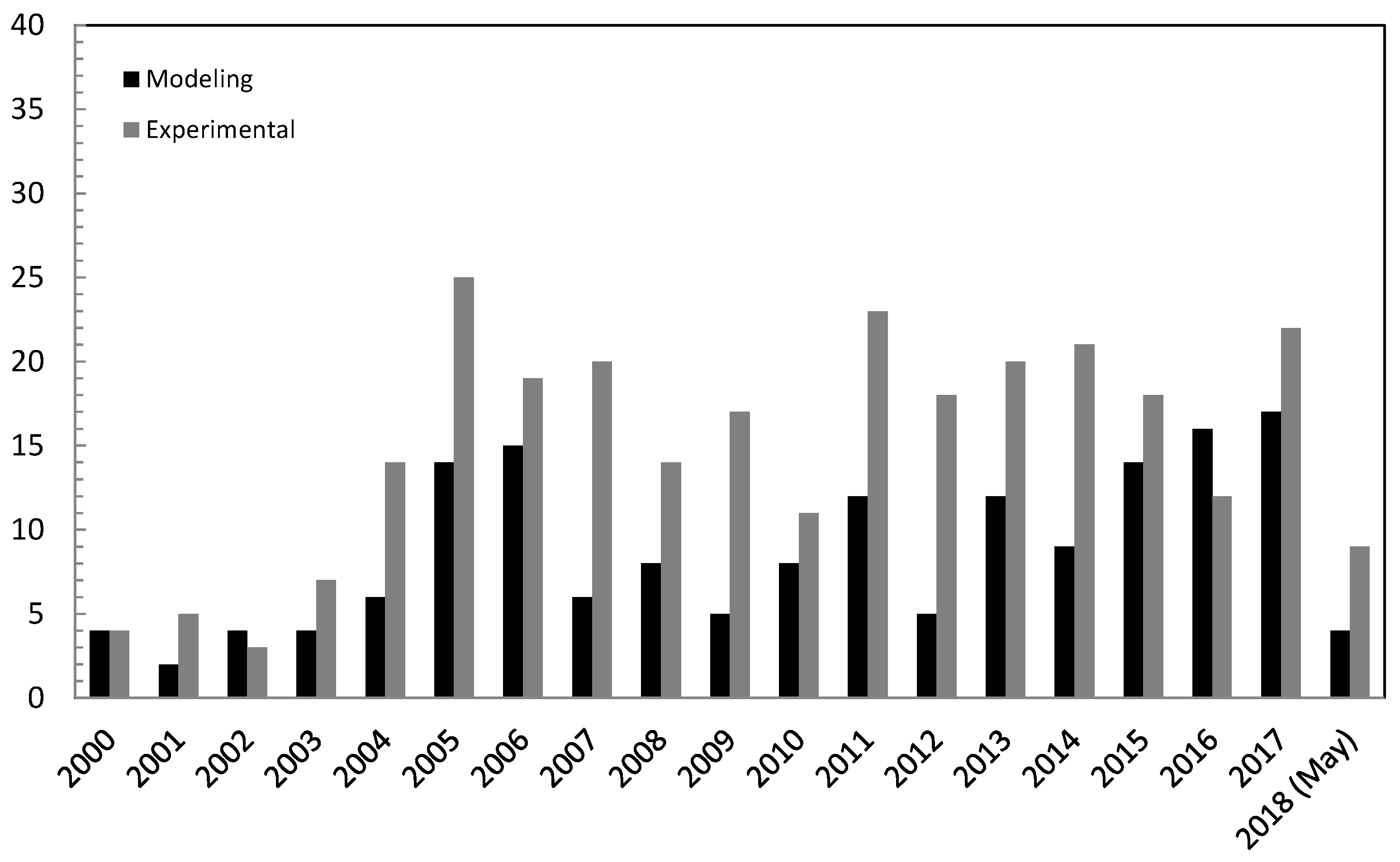
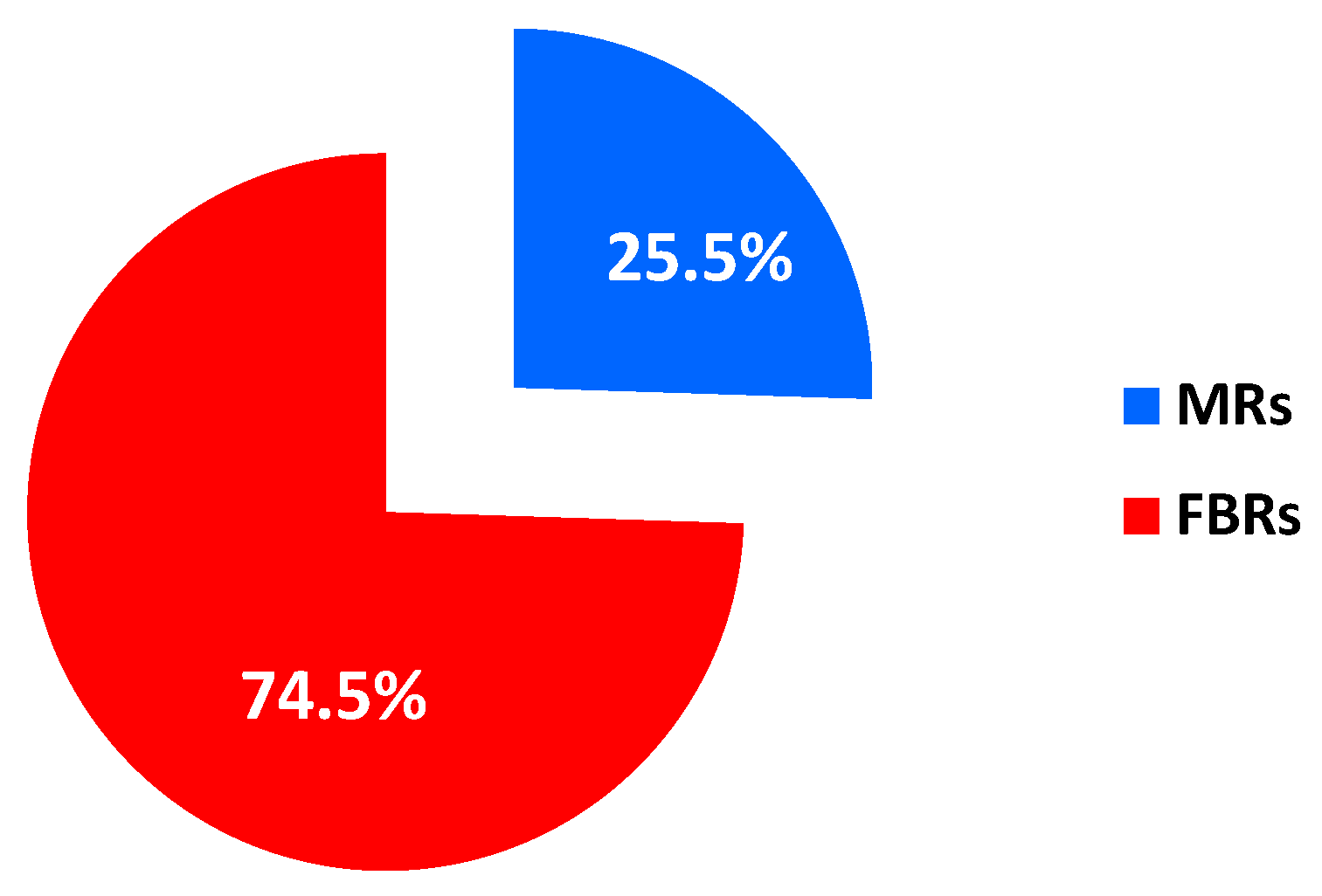
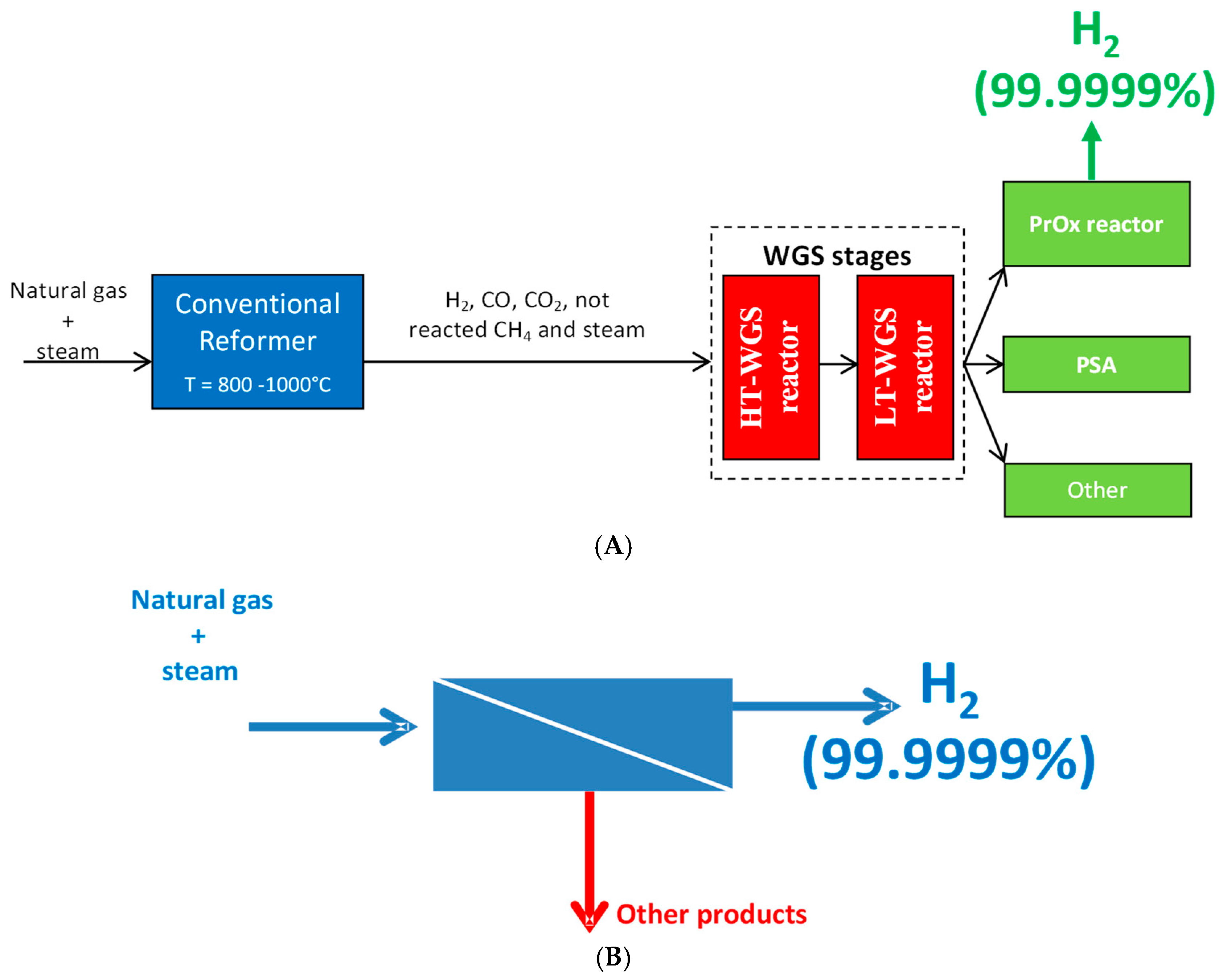
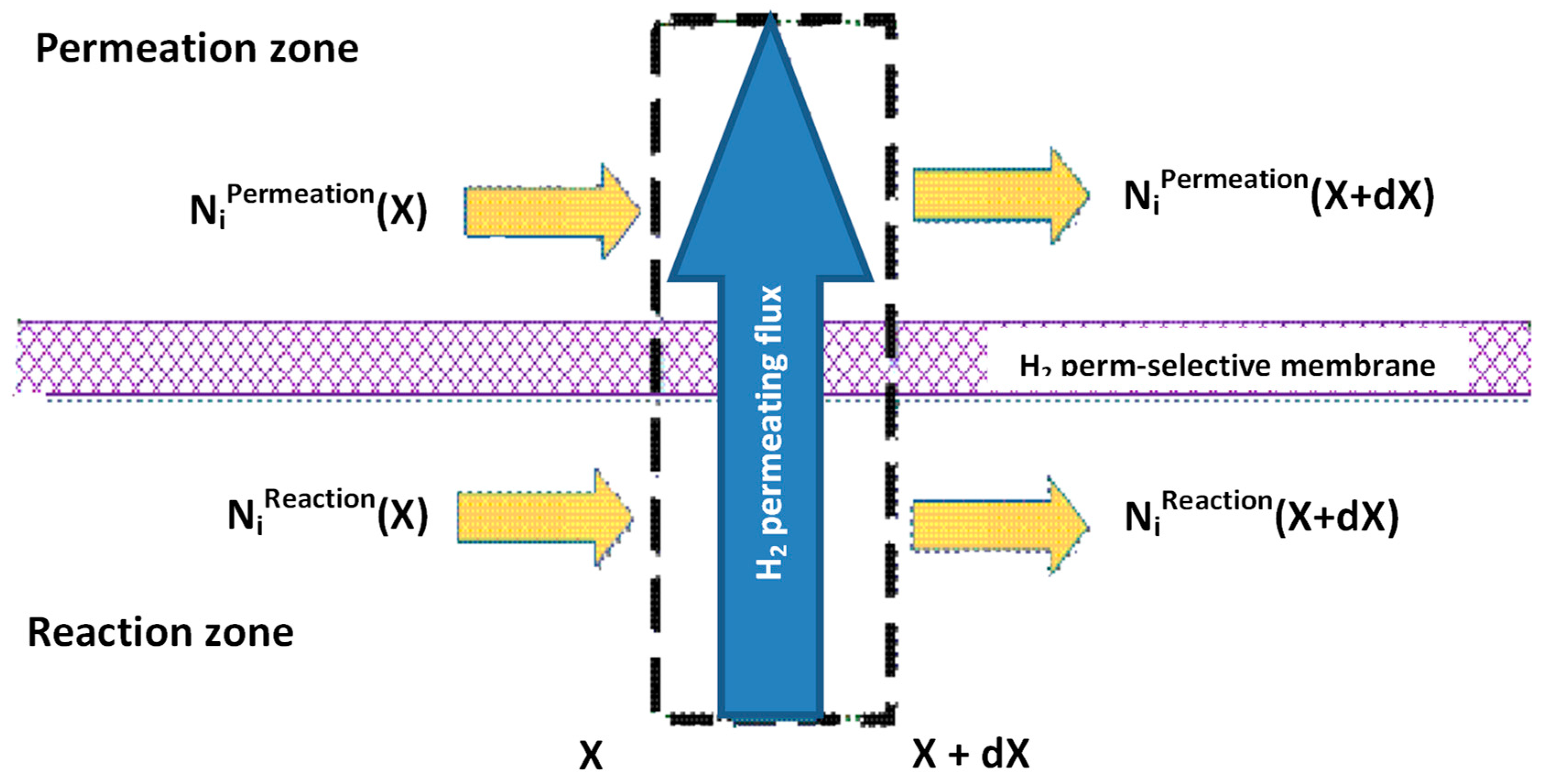
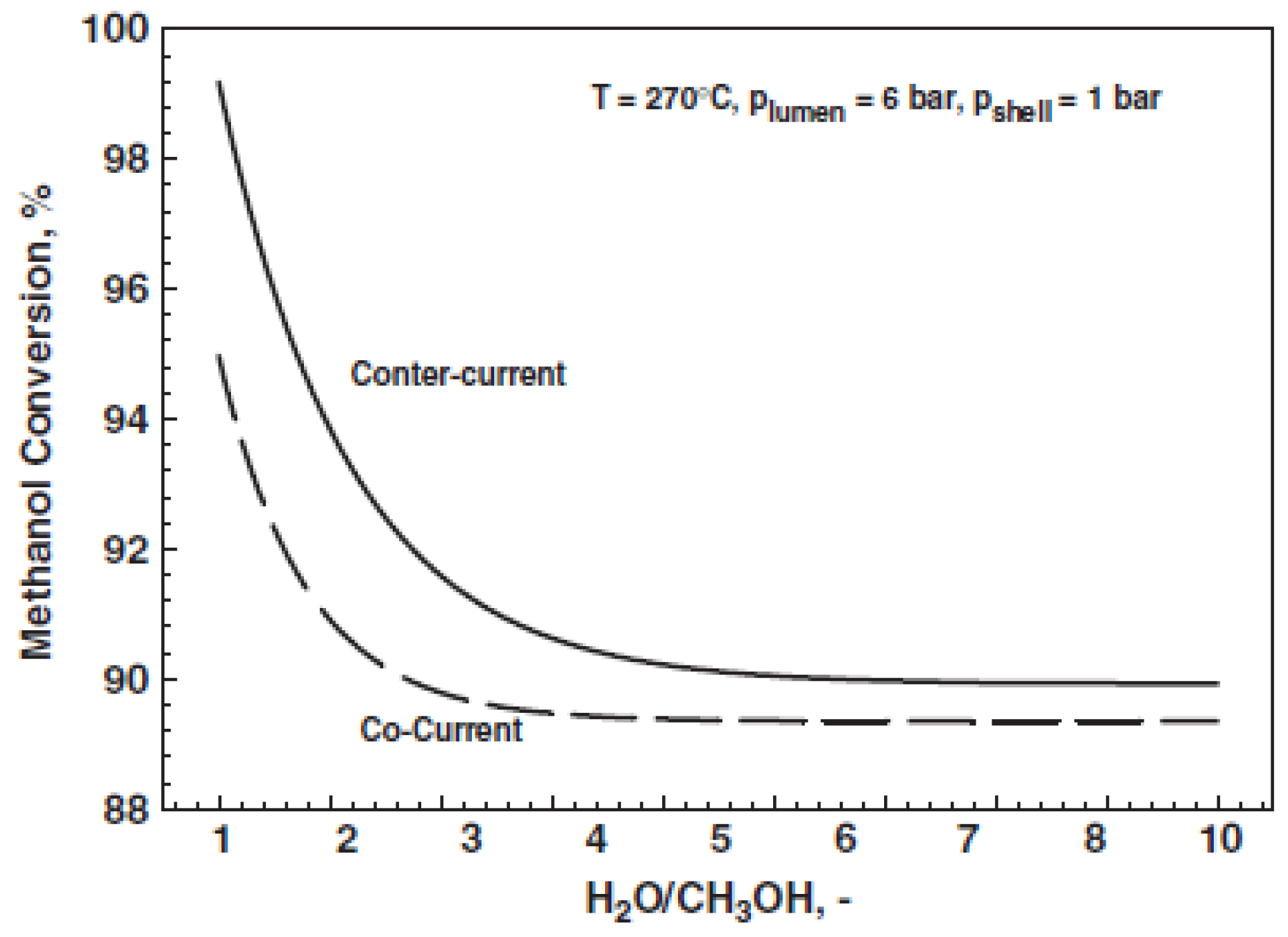
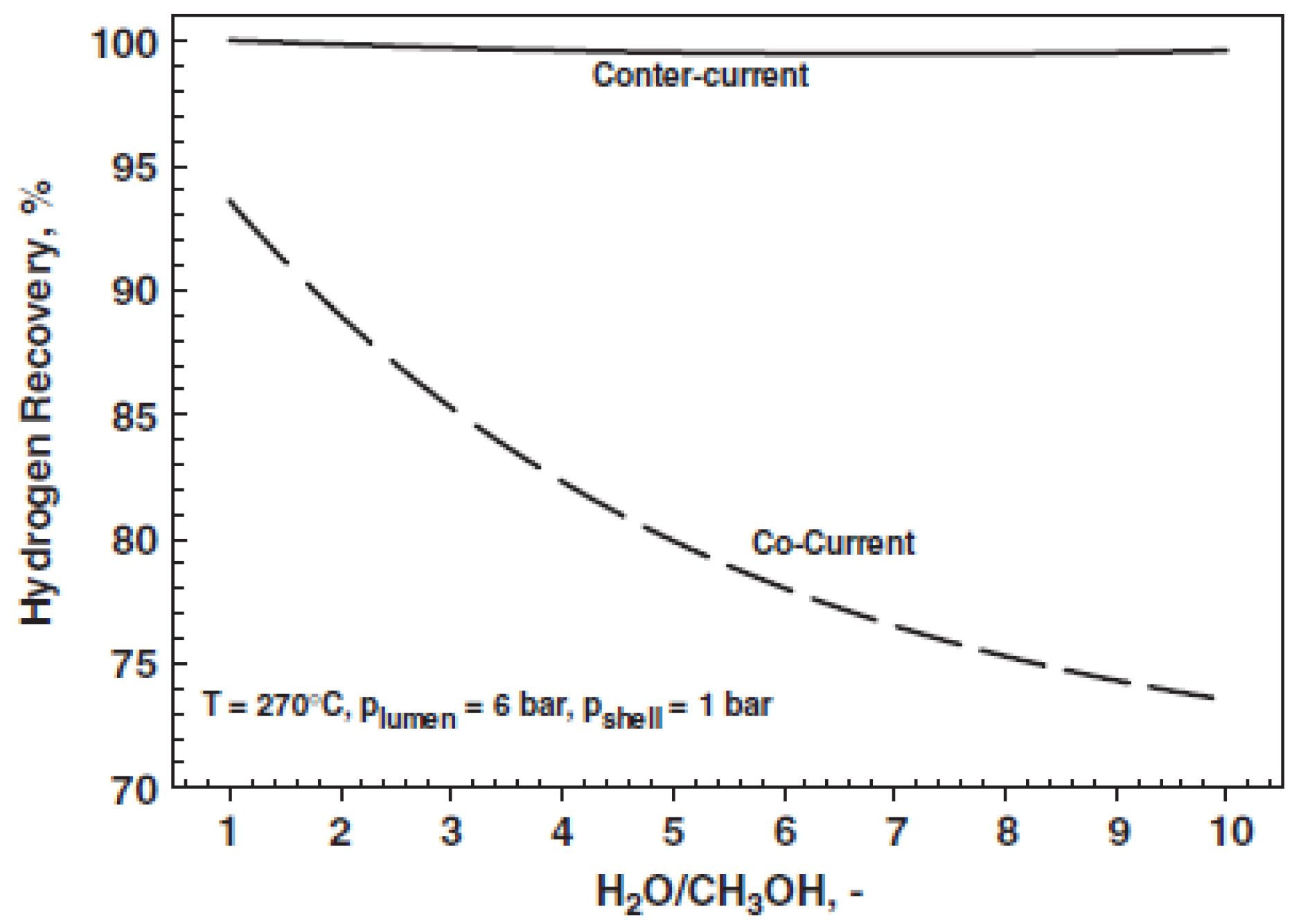

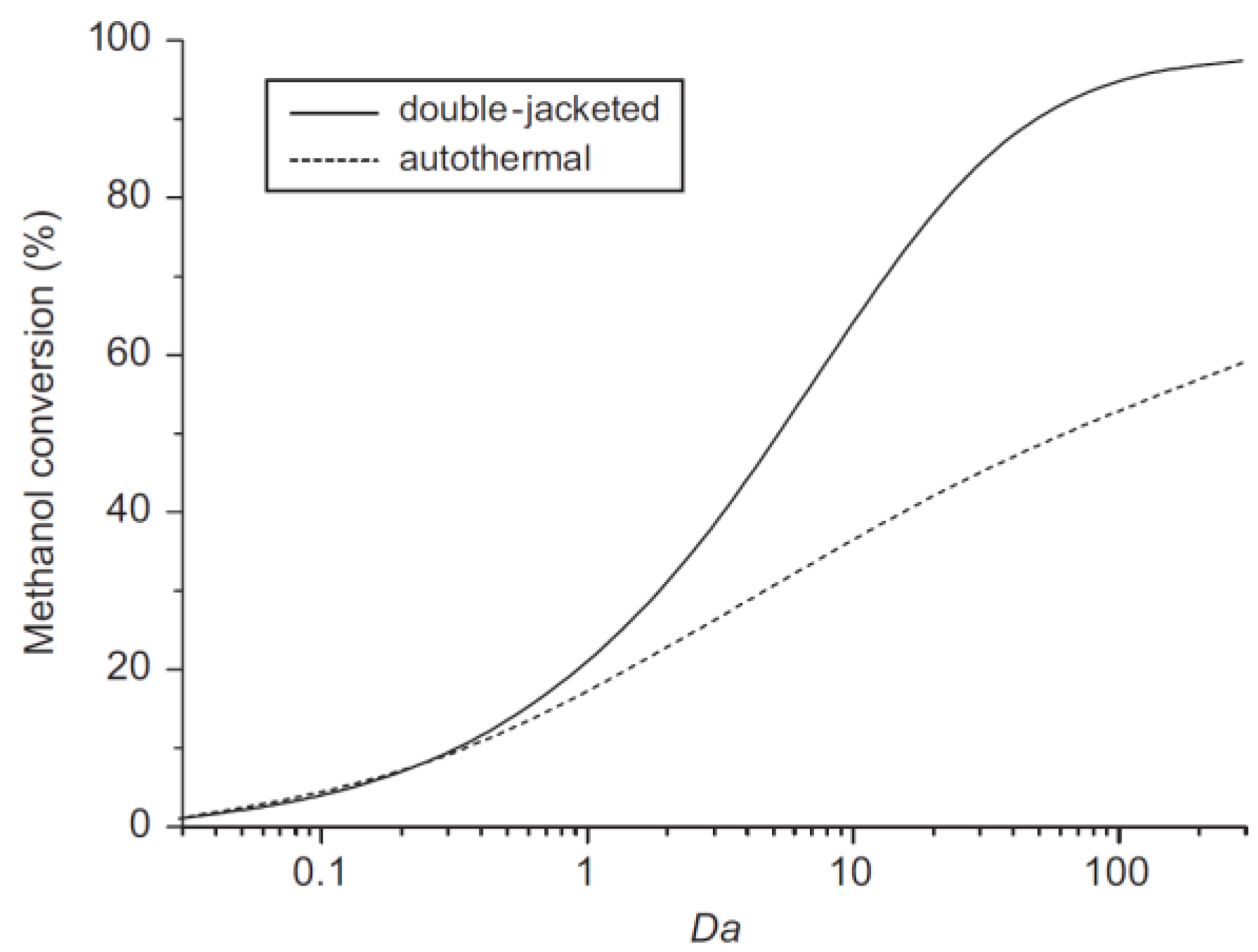

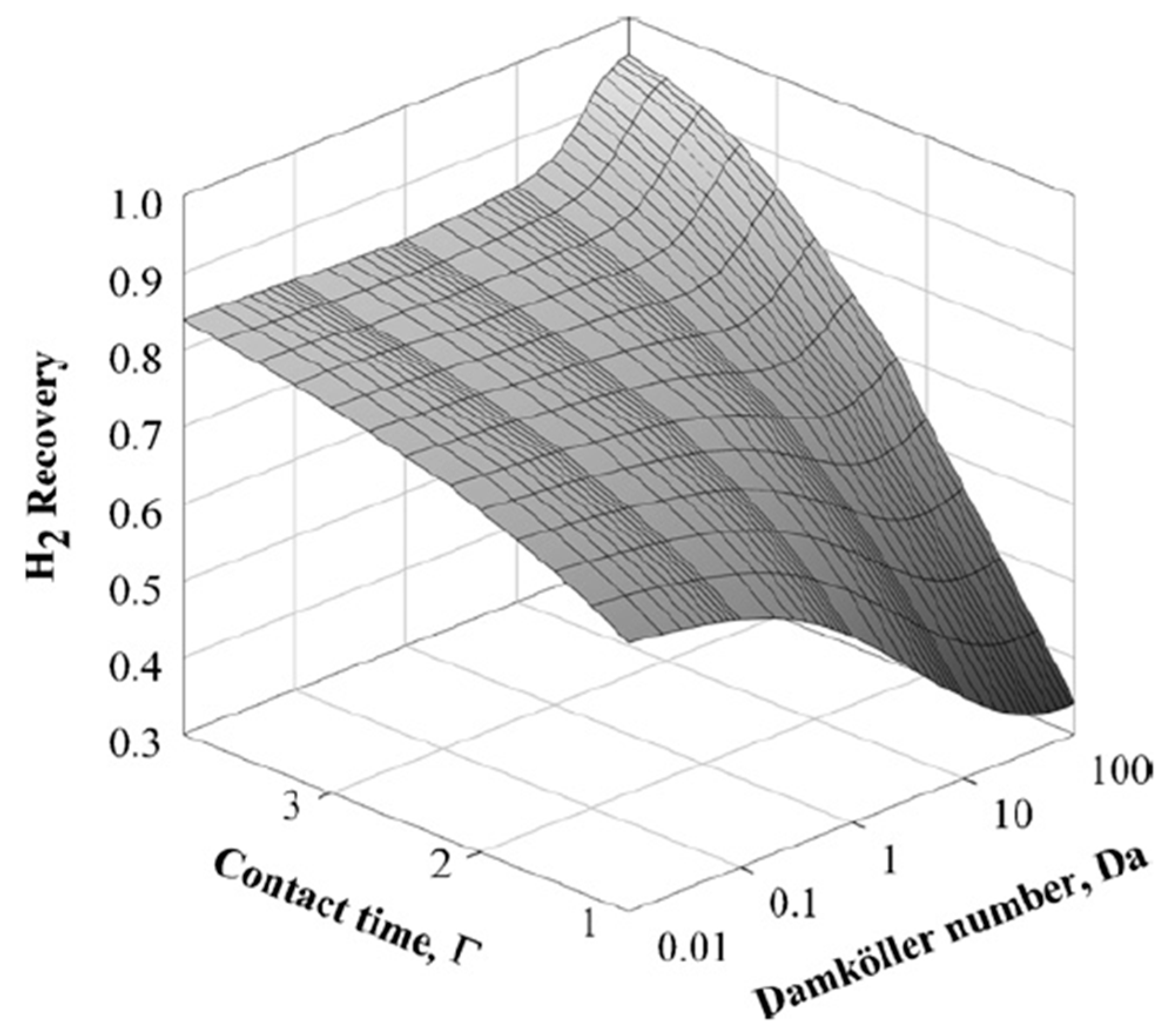
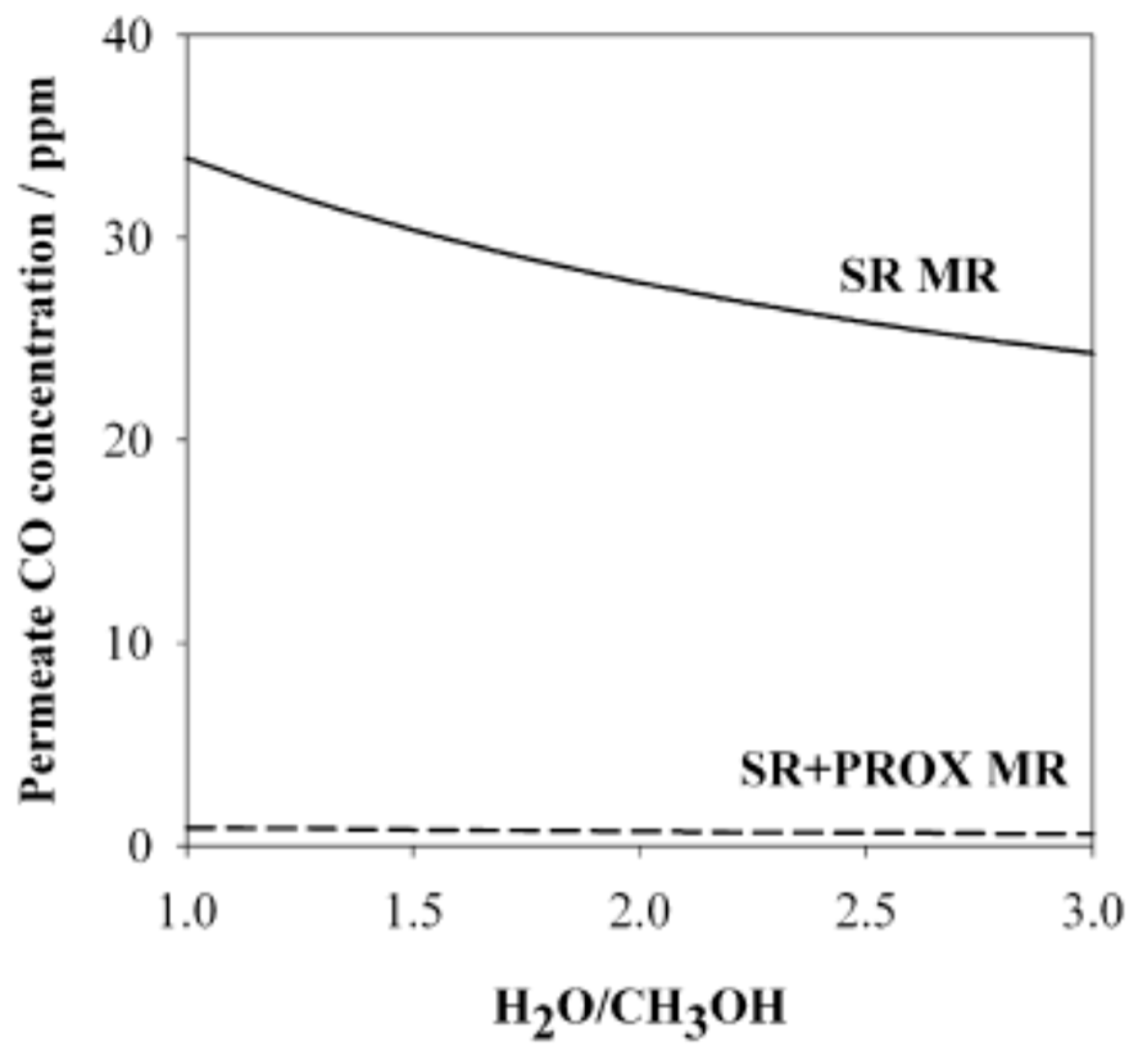
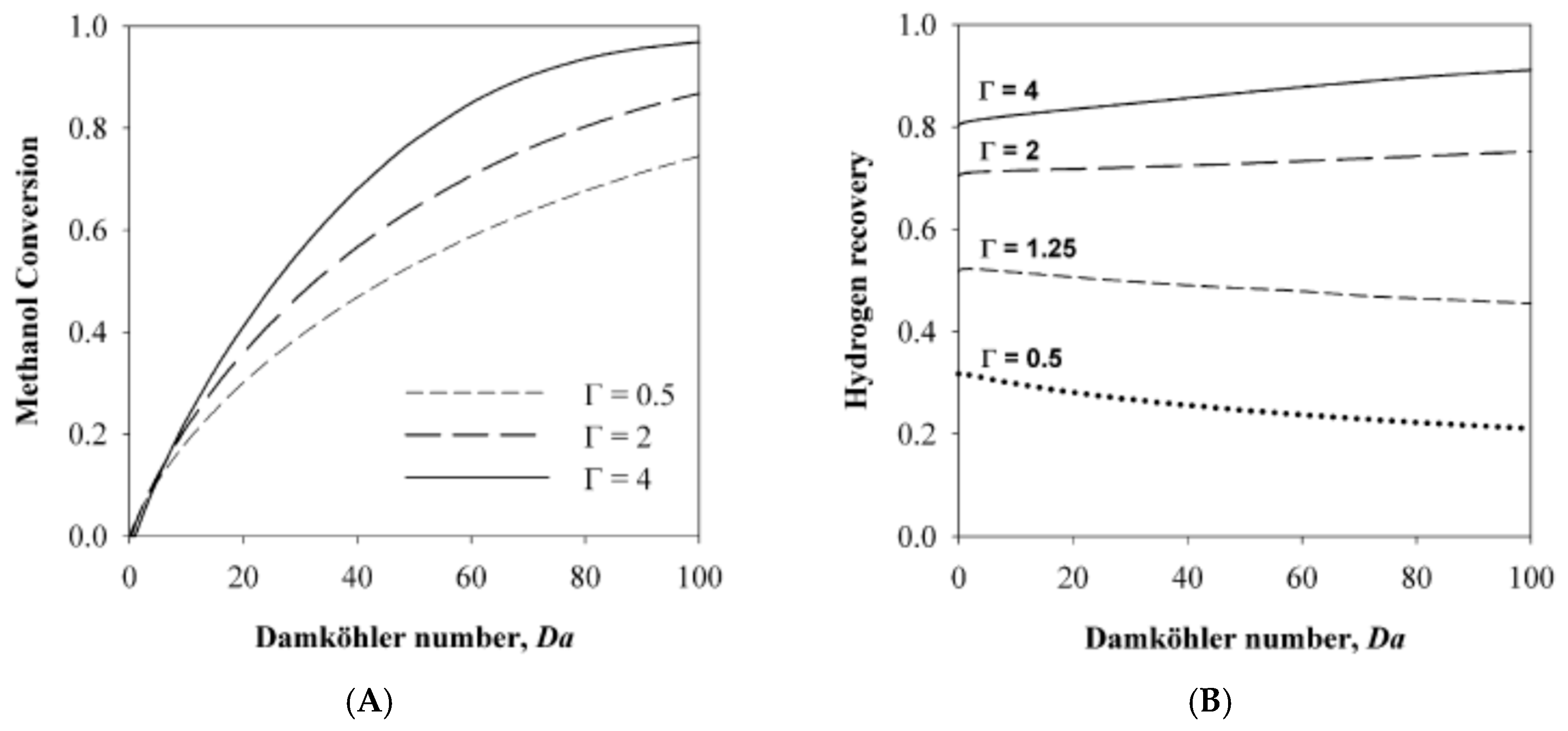
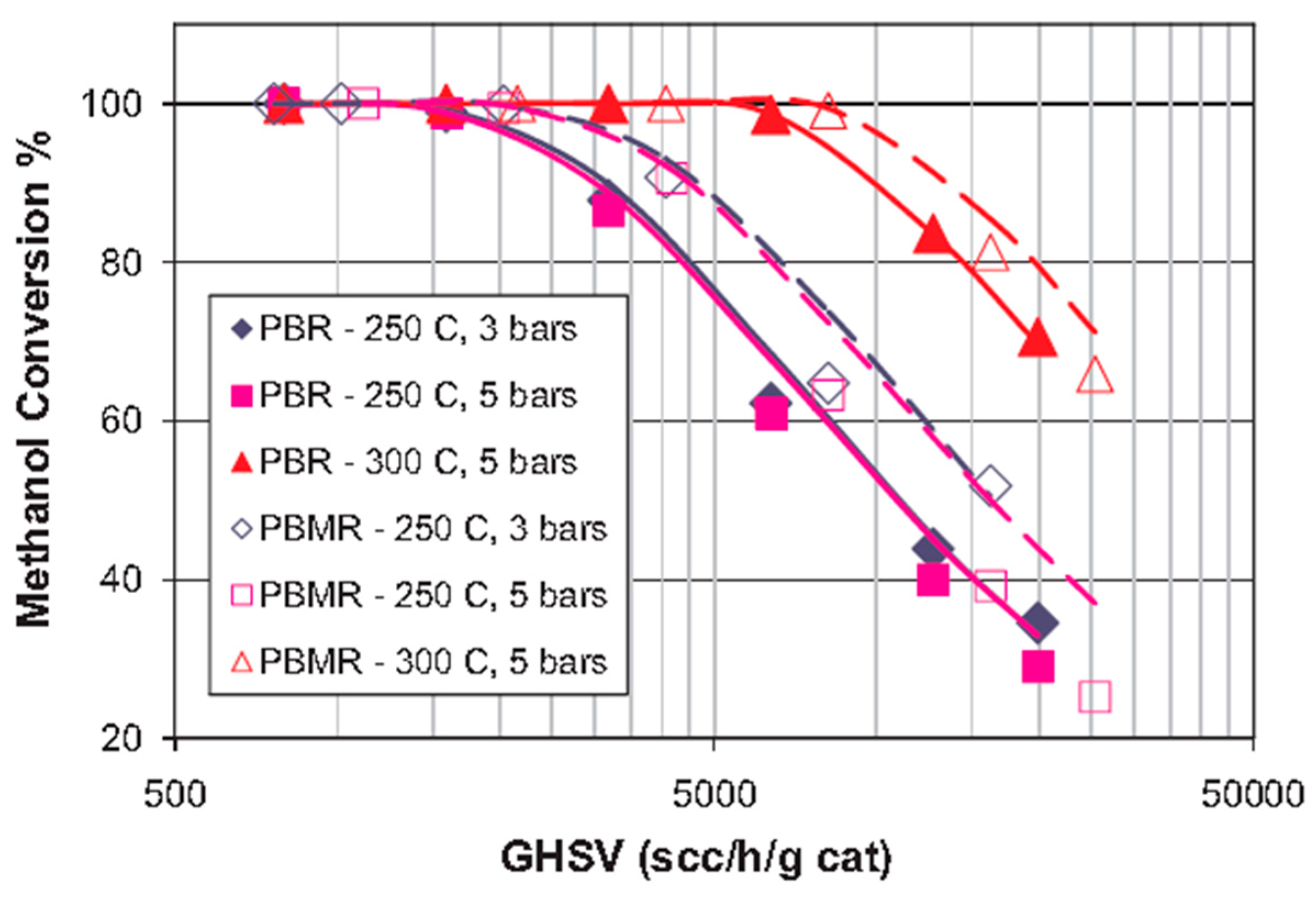
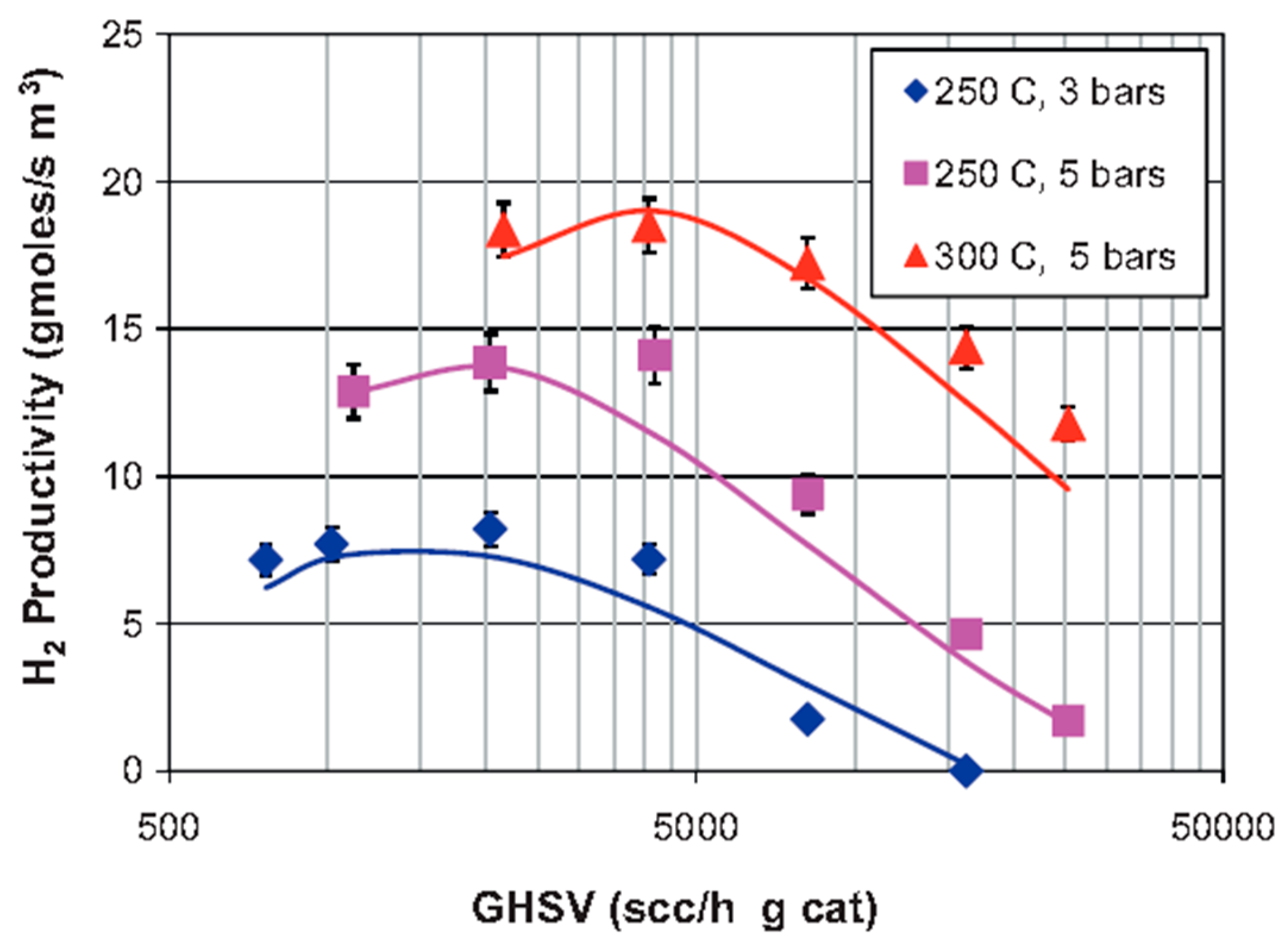
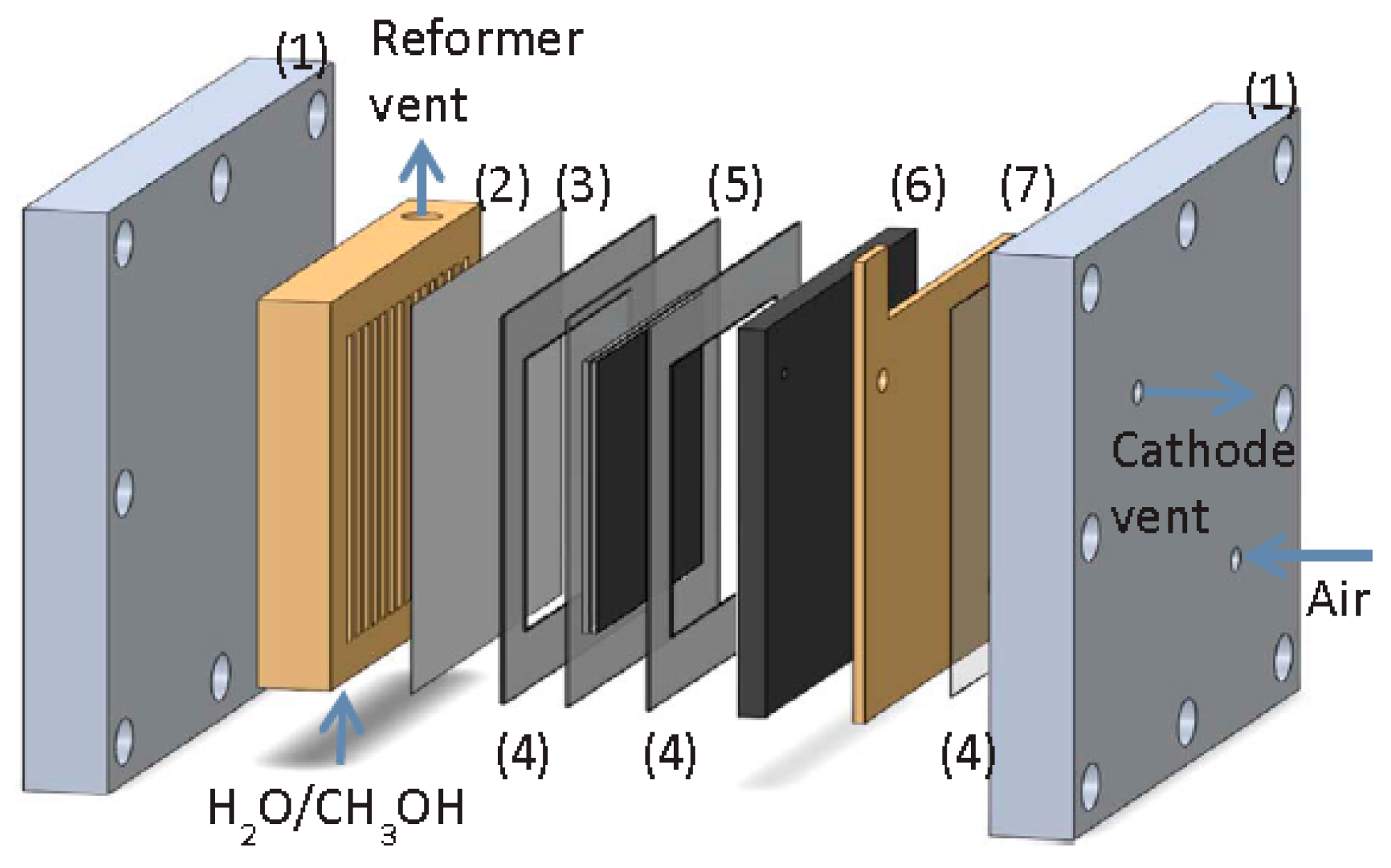
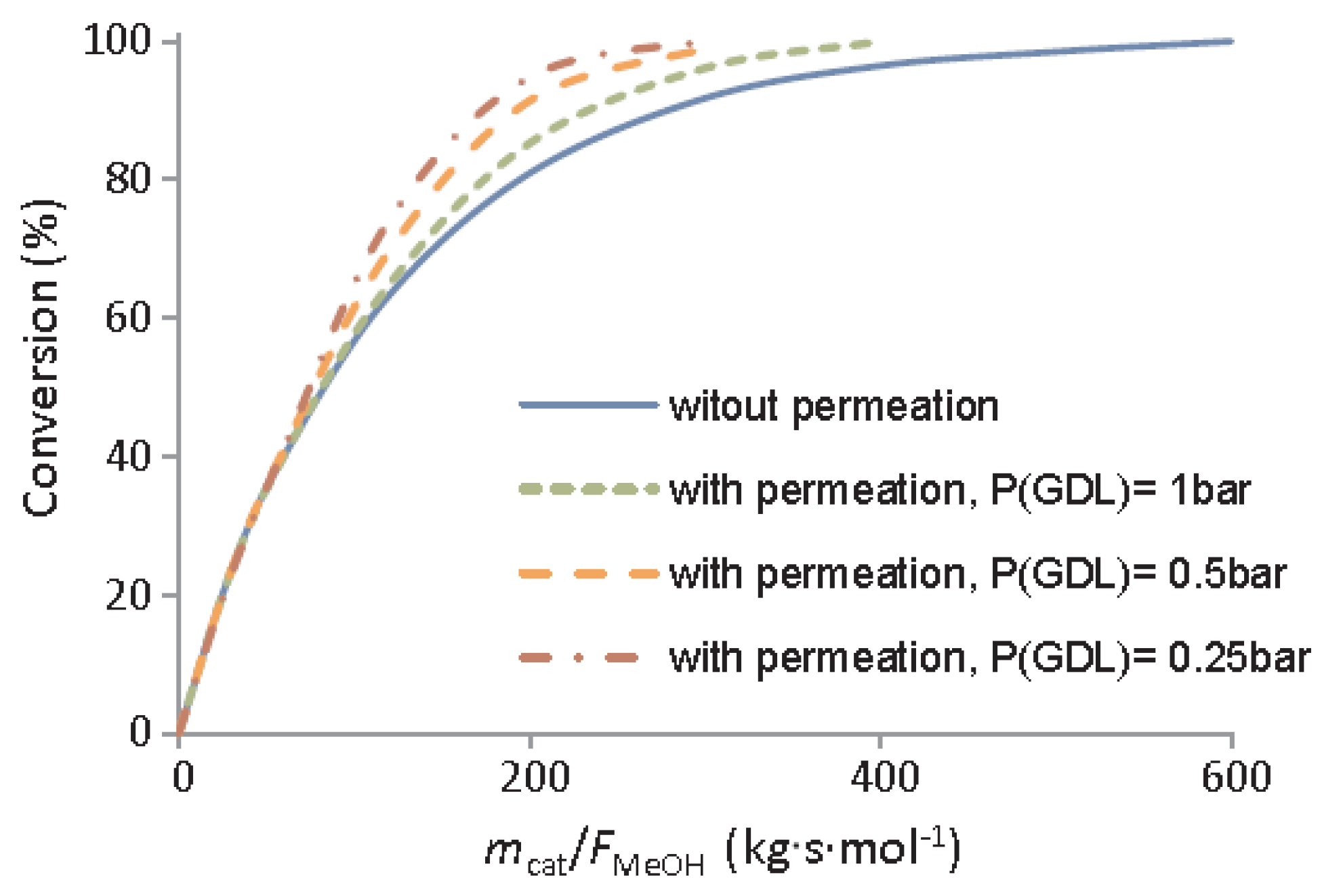
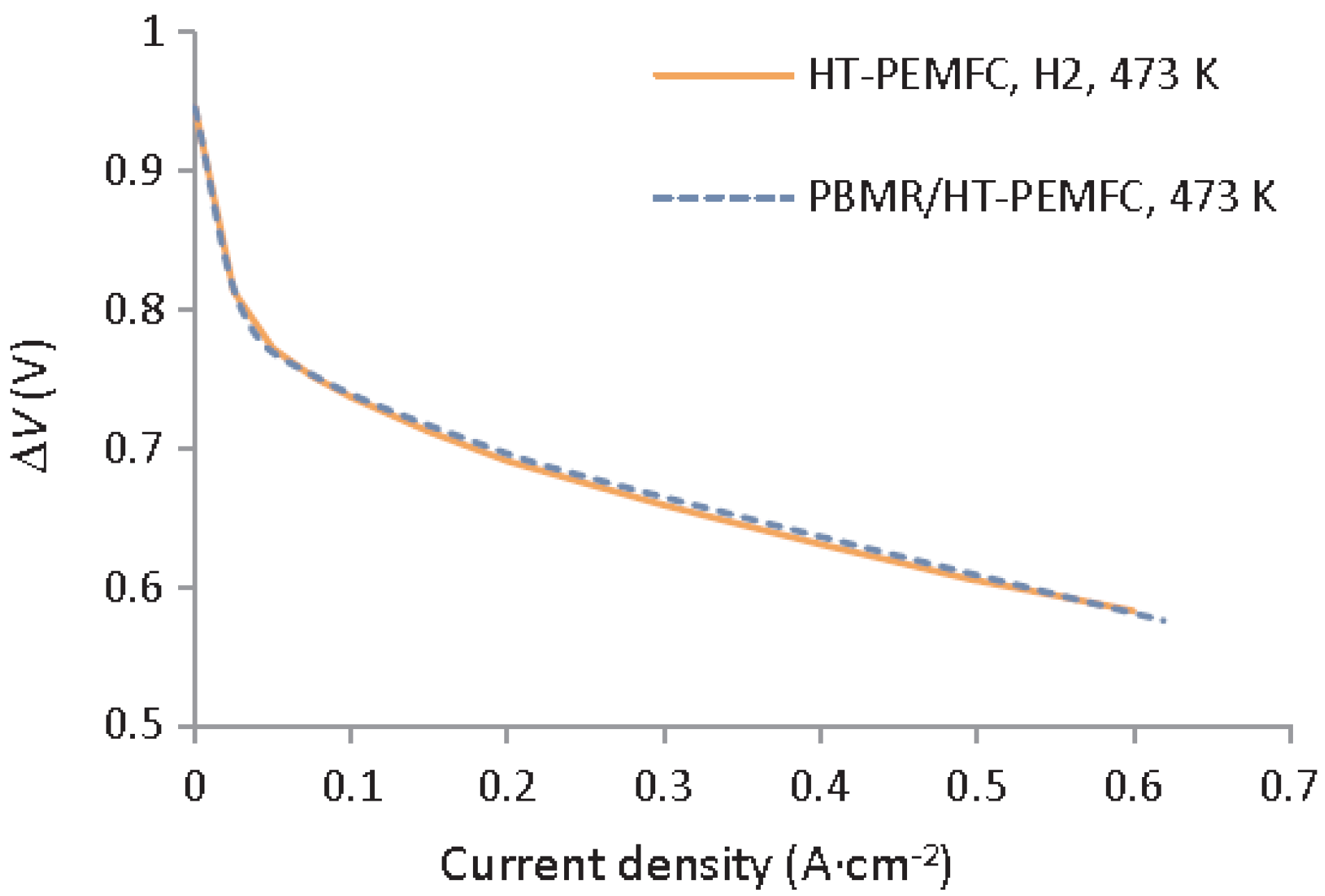

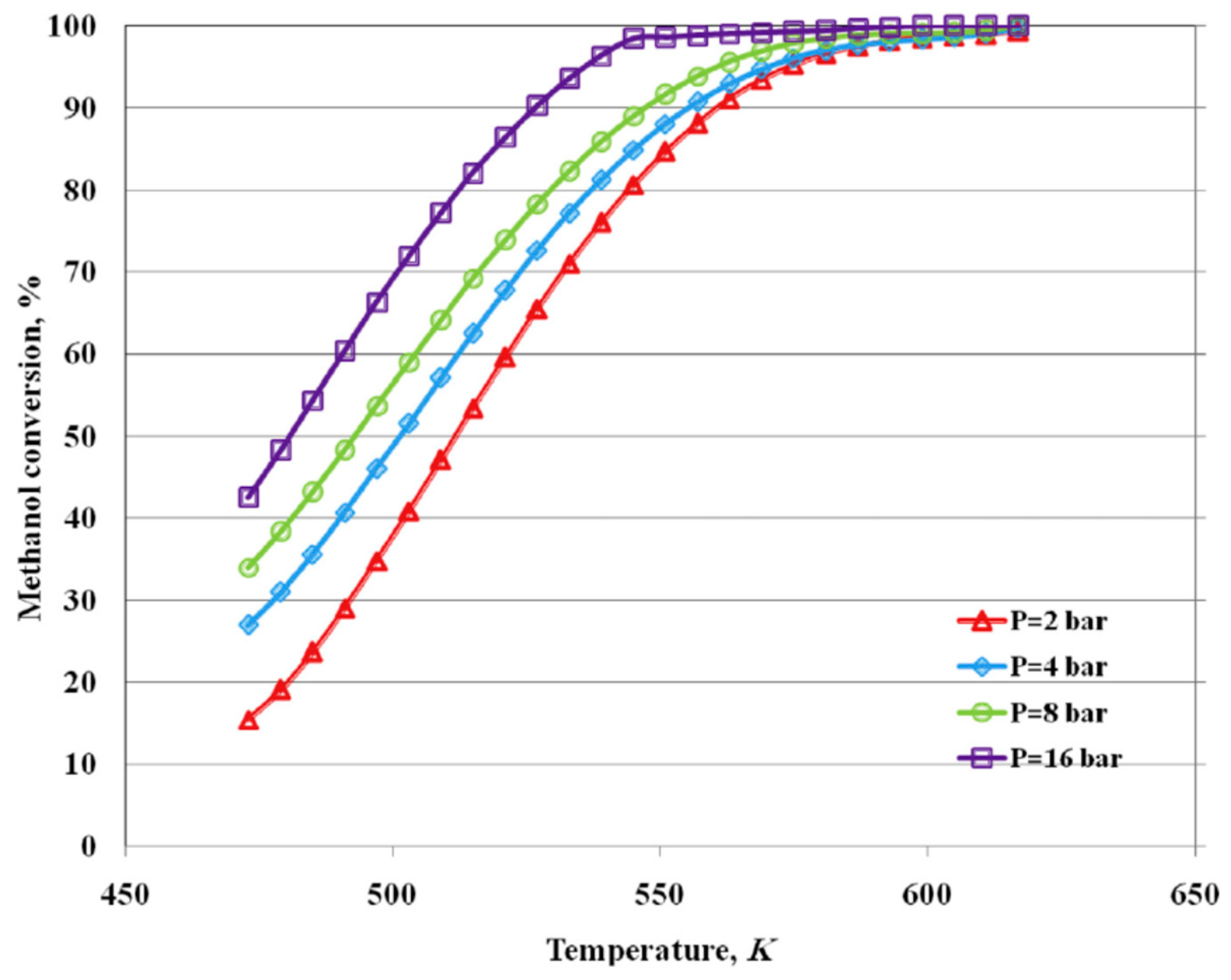
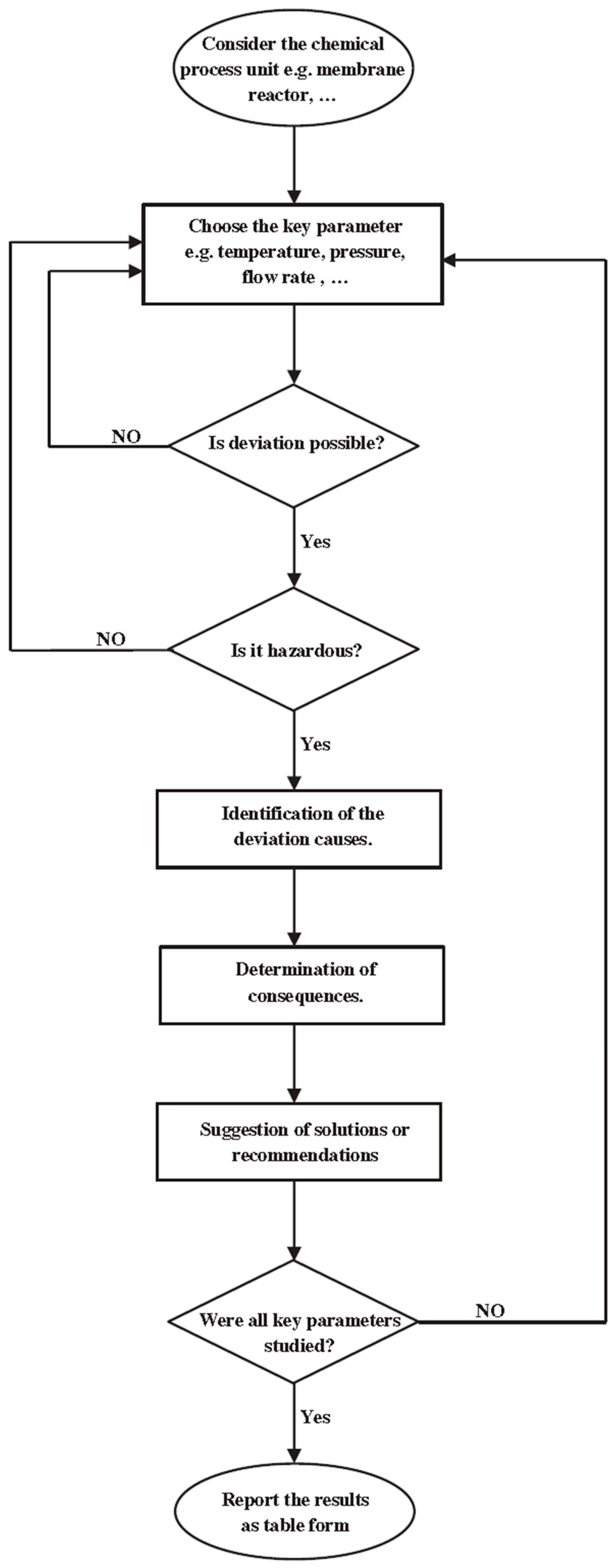
| Guide Words | Causes | Consequences | Recommensations |
|---|---|---|---|
| Less | 1. Heater controller fails |
| 1. Check of the heater controller |
| 2. Lower temperature of feed reactants or HPLC pump fails |
| 2. Check values and lines or HPLC pump | |
| 3. Lower temperature of sweep gas |
| 3. Check the sweep gas cylinder | |
| 4. Isolation of MR set up fails |
| 4. Check of the isolation system | |
| |||
| |||
| Condensation of vapors | |||
| More | 1. Heater controller fails |
| 1. Check control system of heater |
| 2. Higher temperature of feed reactants or HPLC pump fails |
| 2. Check values and lines or HPLC pump | |
| 3. Isolation of MR set up fails |
| 3. Check of the isolation system | |
| |||
| Tolerance | 1. Heater controller fails |
| 1. Check control system of heater |
© 2018 by the authors. Licensee MDPI, Basel, Switzerland. This article is an open access article distributed under the terms and conditions of the Creative Commons Attribution (CC BY) license (http://creativecommons.org/licenses/by/4.0/).
Share and Cite
Iulianelli, A.; Ghasemzadeh, K.; Basile, A. Progress in Methanol Steam Reforming Modelling via Membrane Reactors Technology. Membranes 2018, 8, 65. https://doi.org/10.3390/membranes8030065
Iulianelli A, Ghasemzadeh K, Basile A. Progress in Methanol Steam Reforming Modelling via Membrane Reactors Technology. Membranes. 2018; 8(3):65. https://doi.org/10.3390/membranes8030065
Chicago/Turabian StyleIulianelli, Adolfo, Kamran Ghasemzadeh, and Angelo Basile. 2018. "Progress in Methanol Steam Reforming Modelling via Membrane Reactors Technology" Membranes 8, no. 3: 65. https://doi.org/10.3390/membranes8030065
APA StyleIulianelli, A., Ghasemzadeh, K., & Basile, A. (2018). Progress in Methanol Steam Reforming Modelling via Membrane Reactors Technology. Membranes, 8(3), 65. https://doi.org/10.3390/membranes8030065







